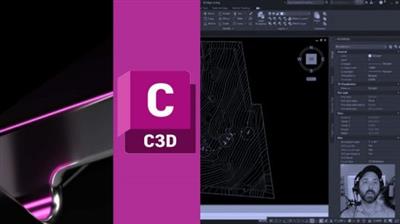 Civil 3D 2023 to 2024 Alignment Essentials
Civil 3D 2023 to 2024 Alignment EssentialsPublished 10/2023
MP4 | Video: h264, 1280x720 | Audio: AAC, 44.1 KHz, 2 Ch
Language: English | Duration: 39m | Size: 603 MB
Examine Creating and Editing Alignments
What you'll learnCreating an Alignment with the Alignment Layout Tools
Adding Free Curves and Spirals to an Alignment
Adding Floating Curves to an Alignment
Editing the Layout Parameter Values of an Alignment
Grip Editing an Alignment Free Curve Entity
Applying a Mask to an Alignment
Creating Offset Alignments
Editing an Offset Alignment
Adding a Widening to an Offset Alignment
Editing an Offset Widening
RequirementsA basic knowledge of AutoCAD commands
DescriptionThe horizontal alignments that serve as the foundation for modeling roadways will be introduced to you in this course.
Alignments are made up of a collection of lines, curves, and spirals that are seen as a single thing.
In addition to pipe networks and other construction baselines, alignment objects can represent road centerlines. One of the first tasks in designing a road, railroad, or site is creating and specifying a horizontal alignment. The named alignment can be made from the alignment geometry, which can be drawn as a polyline. The Alignment Layout Tools can be used to generate an alignment object for more control. Additionally, tangency between the alignment components is automatically maintained when editing alignments using grips or the commands on the Alignment Layout Tools toolbar.
Profiles, sections, and corridors can all have alignments as their parent object or as a stand-alone object. When you modify an alignment, all associated items are automatically updated.
Give an alignment a type when you create it, such as centerline, offset, curb return, rail, or miscellaneous. These alignment types can be used to classify your data according to alignment function. Choose the centerline type for a road centerline, the rail type for a railroad, or the other type for other applications, such as a utility conduit. They are autonomous items of these types.
Curb return and offset alignments can both be independent, but they are frequently dynamically coupled to other alignments. Curb returns and offset alignments can both be generated automatically as intersectional elements. Widenings may also use offsets.
You can determine how the corridor will behave around curves after an alignment has been built. You can compute cant along rail alignments as well as superelevation along centerline, offset, and curb return alignments.
In the Prospector tab, alignments are listed in either the Alignments collection or a Site collection. You can generate reports, alter the alignment characteristics, and export LandXML from these collections.
Who this course is forCivil 3D Beginners
Download linkrapidgator.net:
https://rapidgator.net/file/39915b8b571f2c4b5d5d9506af19a7fb/rrvxd.Civil.3D.2023.to.2024.Alignment.Essentials.rar.html
uploadgig.com:
https://uploadgig.com/file/download/019FdcE261505D13/rrvxd.Civil.3D.2023.to.2024.Alignment.Essentials.rar
nitroflare.com:
https://nitroflare.com/view/ABA59292995BBB0/rrvxd.Civil.3D.2023.to.2024.Alignment.Essentials.rar

